A lot of folks are curious about whether you can drink milk after munching on fish, right? This question has been around for ages. Some people swear it messes with your skin, while others think it’s just an old wives’ tale. All over the world, people steer clear of mixing these two because of old traditions. But nowadays, science has taken a good look at a bunch of these rules. In this article, you’ll find out where this idea came from, what science really says about it, and when you should actually be cautious. By the time you finish reading, you’ll have the scoop on the big question — can we drink milk after eating fish?
Ancient Beliefs and Cultural Origins

For centuries, people have debated whether fish and milk should ever be consumed together. The idea comes mainly from Ayurveda, an ancient Indian system of health and diet. Ayurveda calls such combinations “Viruddha Ahara”, meaning incompatible foods. According to this belief, when two foods with opposite qualities — like warm and cold — are mixed, they can create imbalance in the body.
In Ayurveda, fish is considered “heaty,” while milk is “cooling.” The theory suggests that mixing them may disturb digestion and create toxins in the body. These toxins are believed to cause skin disorders, like white patches or pigmentation. Even today, many people in India and Pakistan still follow this belief and avoid the mix out of caution and tradition.
You will like this: Is Coconut Safe and Healthy for Pregnancy?
Religious and Regional Practices

Religious and cultural habits also shape our food choices. In Islamic, Hindu, and Mediterranean traditions, milk and fish are often kept apart during meals. For example, in some South Asian homes, elders advise waiting several hours before drinking milk after eating fish.
This habit isn’t limited to one culture. In parts of the Middle East and Africa, old sayings warn that milk and fish “don’t swim well together.” These traditions have survived for hundreds of years, even though there’s little scientific evidence to back them up. Such deep-rooted customs show how culture and health beliefs are often intertwined.
Read more: How to Make Lahori-Style Fried Chira Fish – Extra Crunchy Recipe
What Science Says About Mixing Fish and Milk
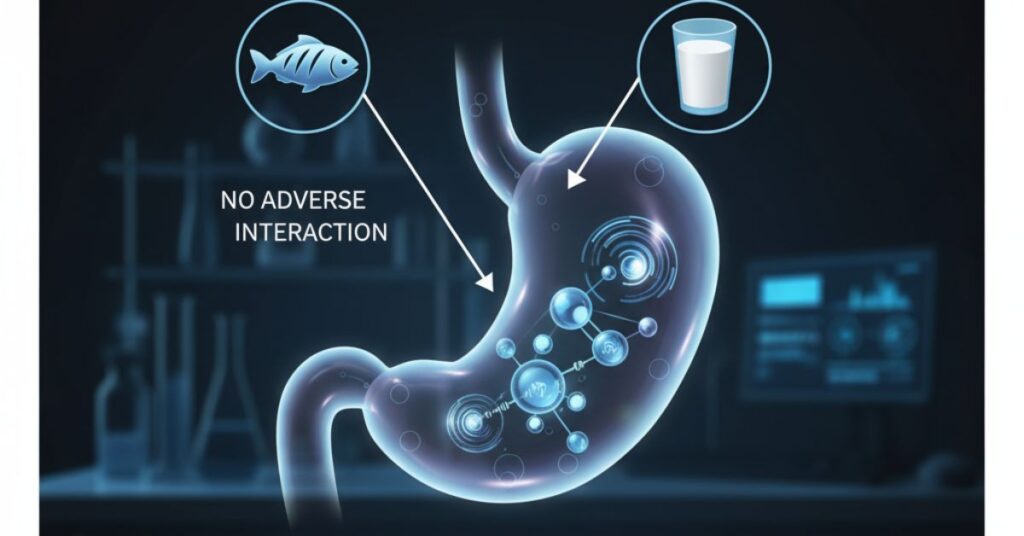
Modern science tells a different story. There’s no proven chemical reaction that makes this combination harmful. Both fish and milk are rich in protein, vitamins, and minerals that support health. Fish provides omega-3 fatty acids, vitamin D, and selenium, while milk offers calcium, vitamin B12, and casein protein.These nutrients don’t clash inside the body. Your digestive system breaks them down separately, using different enzymes. So, there’s no solid reason to fear this combination, unless you already have an allergy or intolerance.
Here’s a simple comparison of their nutrients:
| Nutrient | Fish (100g) | Milk (100ml) |
| Protein | 22g | 3.4g |
| Fat | 12g | 3.6g |
| Vitamin D | 526 IU | 40 IU |
| Calcium | 20mg | 120mg |
| Omega-3 Fatty Acids | 1.5g | 0g |
Myth vs. Reality What Experts Say
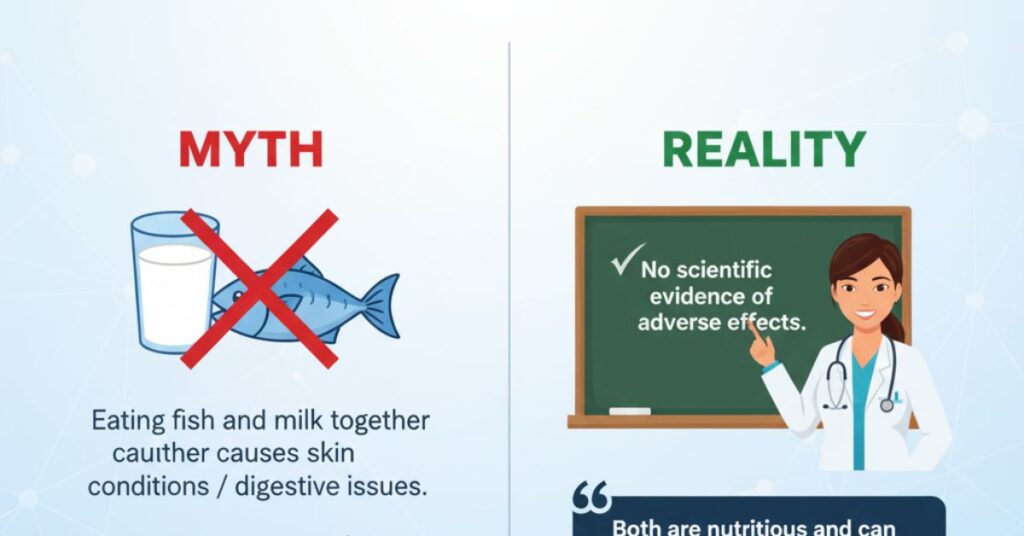
Many people believe drinking milk after eating fish causes white patches on the skin or vitiligo. However, dermatologists and nutritionists disagree. There’s no medical evidence linking this combination to any skin disease. Vitiligo is an autoimmune condition, not something caused by food pairing.Doctors agree that both foods are safe for most people. However, allergies can make certain combinations uncomfortable for some.
Here’s a quick look at some popular myths versus real facts:
| Myth | Reality |
| Drinking milk after fish causes white patches. | No scientific proof. Skin diseases like vitiligo aren’t related to food combinations. |
| Fish and milk create toxins in the body. | The body digests both foods safely. |
| This mix causes stomach upset. | Only in people with lactose intolerance or seafood allergies. |
When You Should Avoid This Combination
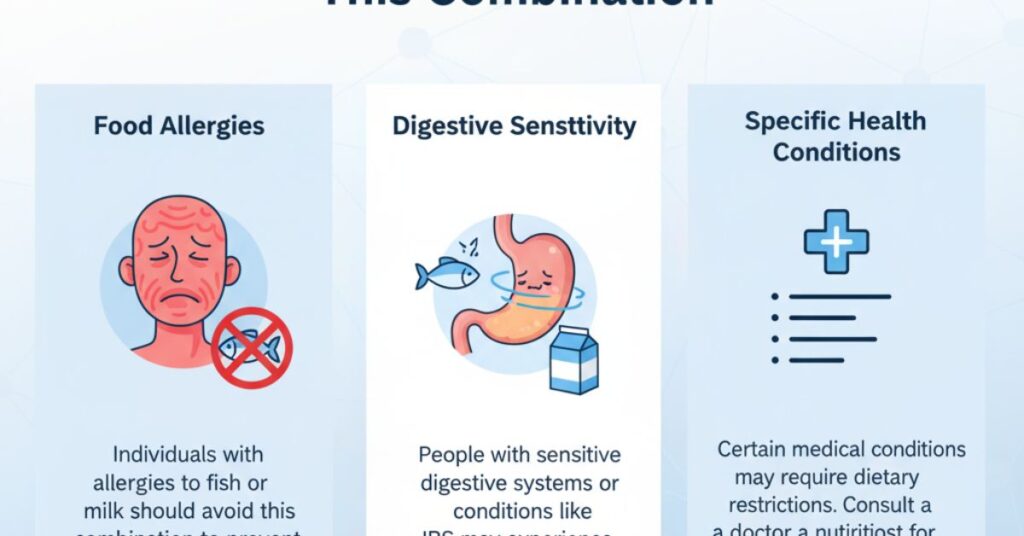
Although milk after fish isn’t harmful for everyone, it can cause issues for some. If you’re lactose intolerant, your body lacks the enzyme needed to digest milk sugar. This may lead to bloating, cramps, or diarrhea. Likewise, if you’re allergic to seafood, even a small amount of fish can trigger reactions like rashes, nausea, or swelling.
People with sensitive digestion should also be careful. For them, combining high-protein foods might slow digestion and cause discomfort. If you notice such symptoms, avoid the mix and consult a doctor. Otherwise, it’s safe for most healthy people.
Safe Time Gap Between Fish and Milk
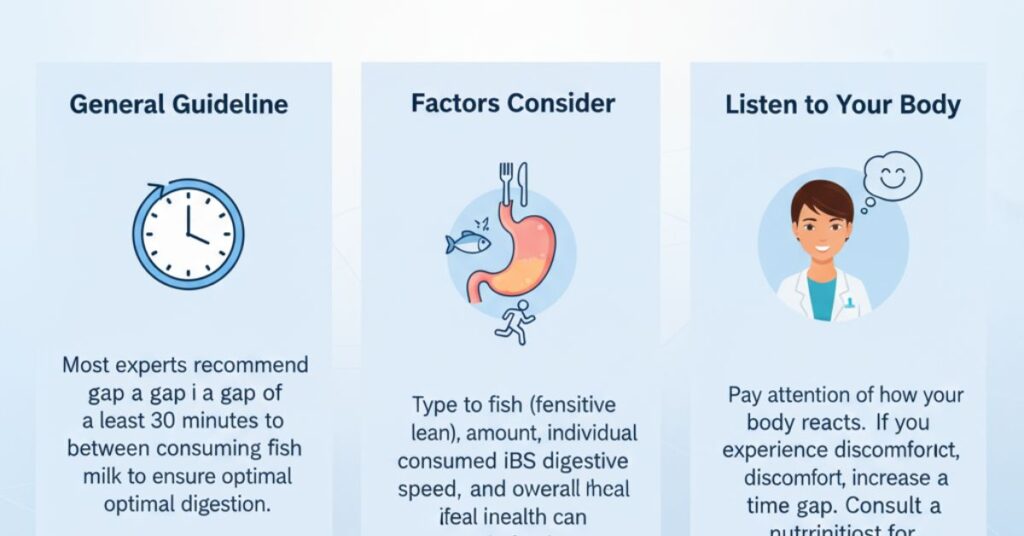
If you’re still cautious, you can simply wait a while before drinking milk after eating fish. Digestion time depends on the meal size, but experts suggest waiting at least 2 to 3 hours. This allows your stomach to process the fish first before introducing milk.Waiting gives your stomach enough time to digest each food properly and can prevent discomfort in people with sensitive stomachs.
Here’s an estimated digestion timeline:
| Food Type | Average Digestion Time |
| Fish | 45 minutes to 1 hour |
| Milk | 1.5 to 2 hours |
| Mixed Meals | 2 to 3 hours |
Healthy Alternatives and Food Pairings
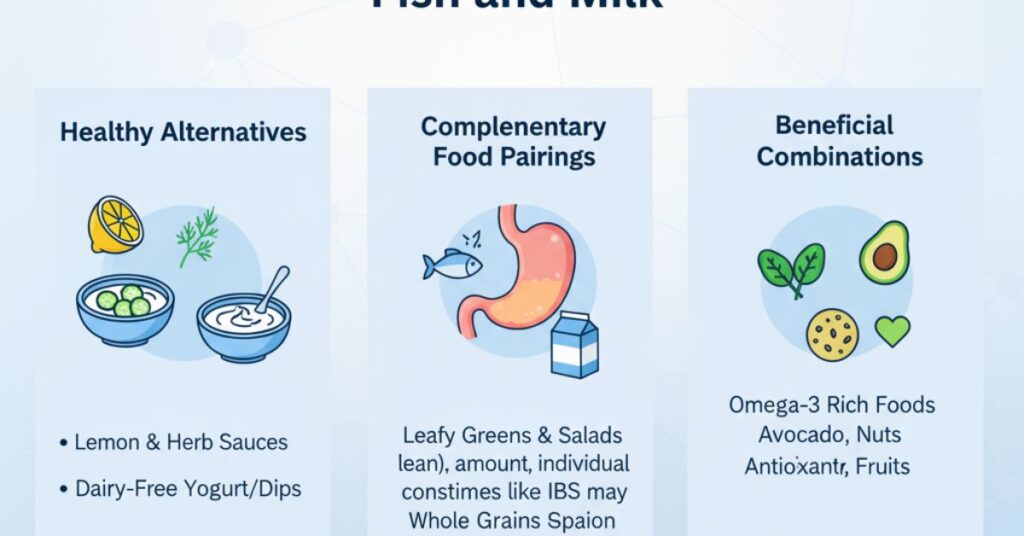
If you still feel unsure about mixing fish and milk, there are plenty of alternatives. You can replace milk with plant-based options like almond milk, soy milk, or coconut milk. These are lighter and easier to digest for many people.
For example, fish dishes often taste great with yogurt-based sauces or light lemon dressings. Yogurt is slightly fermented, which helps digestion. So instead of avoiding milk completely, you can choose probiotic-rich dairy that supports gut health while still enjoying fish meals.
Expert Opinions and Medical Insights
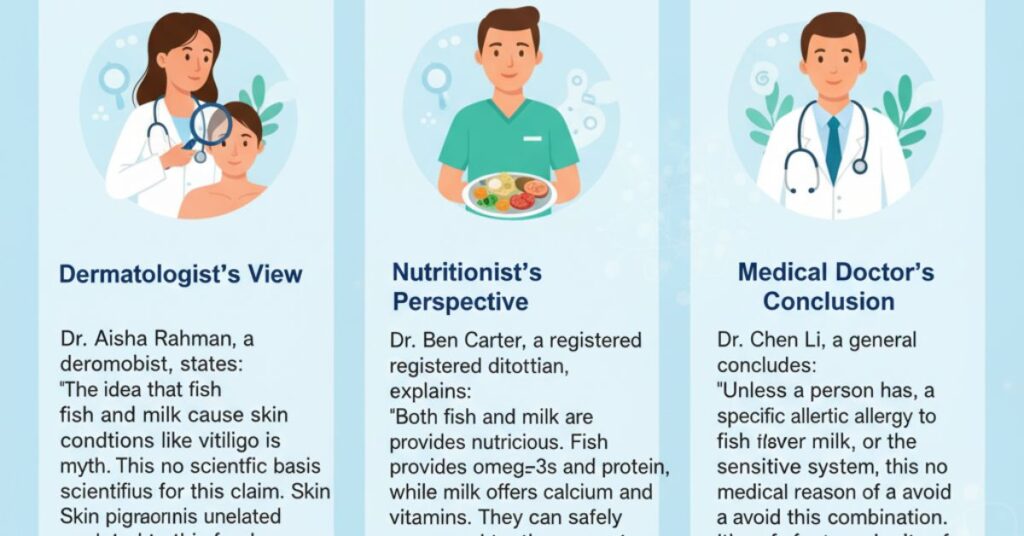
Nutritionists and dermatologists have spoken clearly on this topic. Dr. Vandana Sheth, a registered dietitian nutritionist, explains, “There’s no biological reason that milk and fish can’t be eaten together.” Similarly, dermatologists like Dr. Meera Shah confirm that “skin pigmentation disorders have nothing to do with what food combinations you eat.”
Medical studies published in the Food Chemistry and Nutrition Journal also support this. None of them found any toxic reactions or harmful effects from consuming milk and fish in the same meal. In fact, both foods contribute valuable nutrients that can boost health when included in a balanced diet.
Case Study The Modern Diet Example
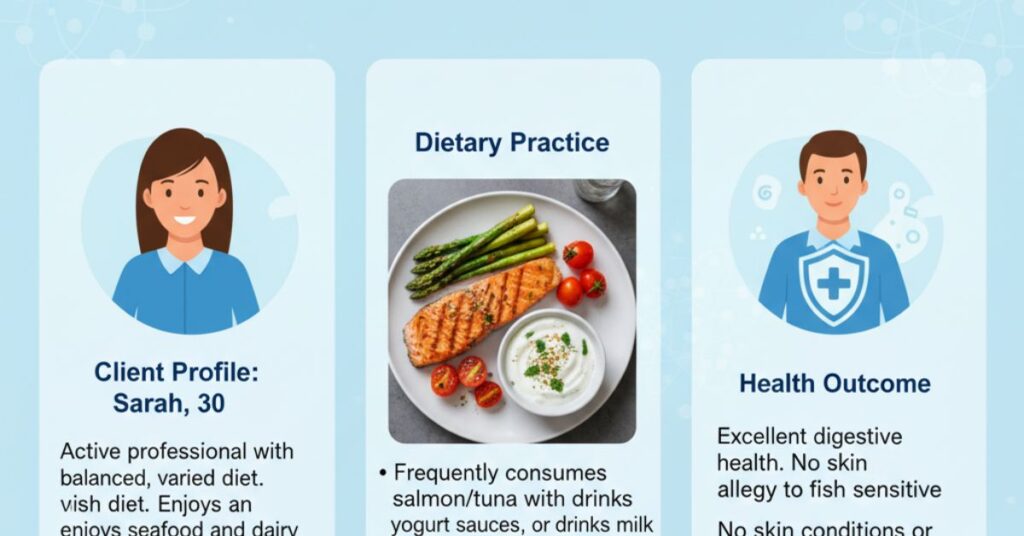
Consider the Japanese diet. It includes seafood daily, along with dairy products like cheese and milk in many meals. Yet, Japan has one of the world’s highest life expectancies and lowest rates of skin diseases. This proves that eating fish and milk together is not harmful for everyone. It all depends on your body’s response and overall diet quality.
Similarly, in Mediterranean cuisine, dishes like salmon in cream sauce or fish chowder with milk are common. These recipes have been eaten for centuries without health problems. This real-world evidence supports what science already says — the combination is safe for most people.
Modern Dietary Science and the Role of Digestion
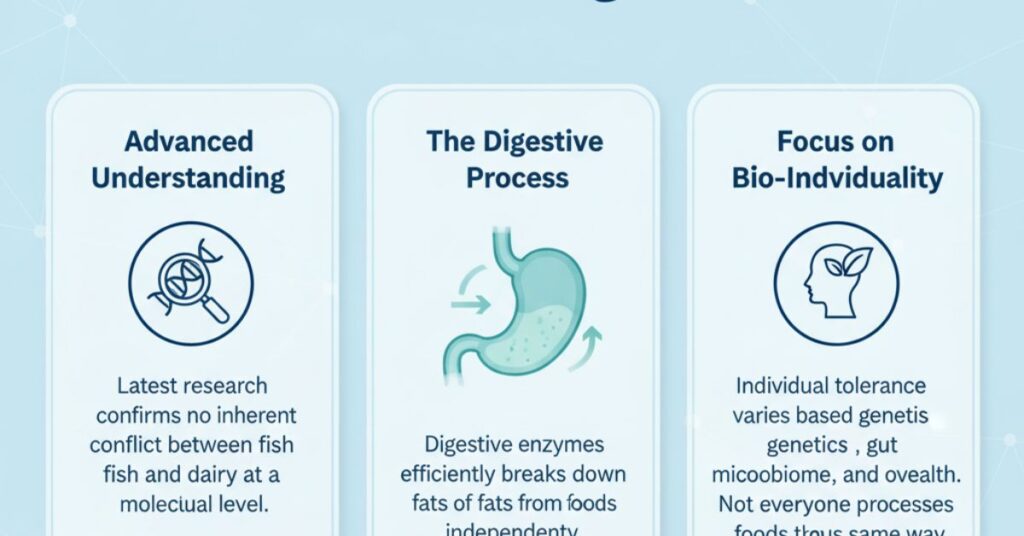
Today, nutrition science focuses more on digestion and individual response than on ancient food taboos. When you eat fish and milk, your body handles them separately. Enzymes like pepsin and lipase break down fish proteins and fats, while lactase processes the sugar in milk. Unless your body lacks lactase or you’re allergic to seafood, there’s no conflict during digestion.
Modern dietitians emphasize gut health as the real key. If your gut flora is balanced, you can digest various food combinations easily. Problems arise only when the digestive system is weak or overloaded. Drinking enough water, eating fiber-rich foods, and avoiding overeating can keep your stomach in good condition, making the combination of fish and milk perfectly safe for most people.
Balancing Tradition and Science
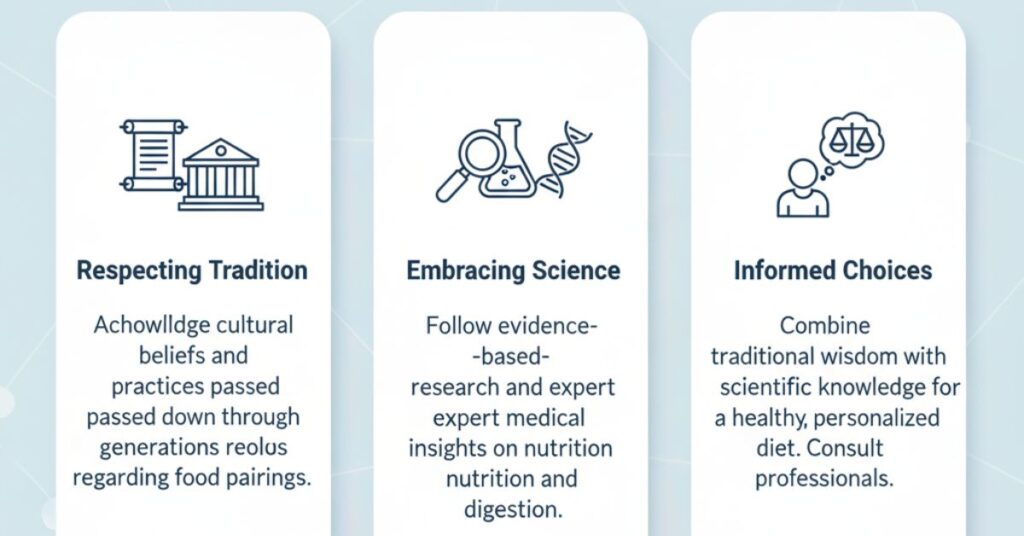
Traditions often carry wisdom, but science helps separate myths from facts. It’s important to respect cultural beliefs, yet also to rely on evidence. The truth is, can we drink milk after eating fish isn’t a question of danger but of individual tolerance. What bothers one person might not affect another at all.
If you come from a family that avoids mixing these foods, it’s okay to follow that for comfort. But if you enjoy dishes like creamy fish soups or chowders, there’s no reason to stop. As long as your digestion is fine and you’re not allergic, both fish and milk can be part of a healthy diet. Balance, moderation, and awareness are the real secrets to good eating.
FAQ’’S
Is it dangerous to drink milk after eating fish?
No, it’s not dangerous. Science shows no harmful reactions between milk and fish in the body.
How long should I wait between eating fish and drinking milk?
It’s best to wait about two to three hours, especially if you have a sensitive stomach.
Does this combination cause skin diseases like vitiligo?
No, skin conditions like vitiligo are autoimmune, not caused by mixing foods.
Can kids drink milk after eating fish?
Yes, it’s safe for kids unless they have a seafood or dairy allergy.
Does milk reduce the smell or nutrients of fish?
No, milk doesn’t affect the nutrients or smell of fish when consumed at different times.
Conclusion
After all the discussion, one thing is clear. Drinking milk after eating fish doesn’t cause diseases or skin problems. Modern science supports that both are safe and healthy when consumed properly. If you don’t have any allergies or digestion issues, you can freely enjoy both. So next time someone asks you, can we drink milk after eating fish, you’ll know the truth. It’s safe, natural, and part of many balanced diets worldwide.

